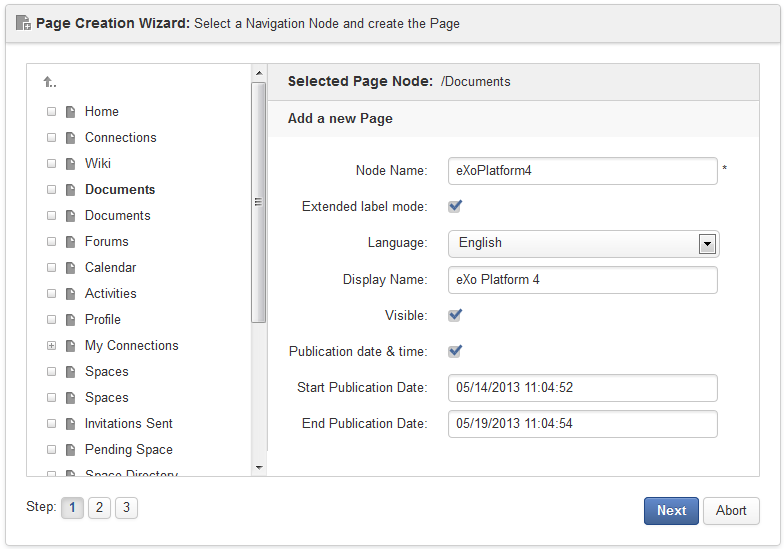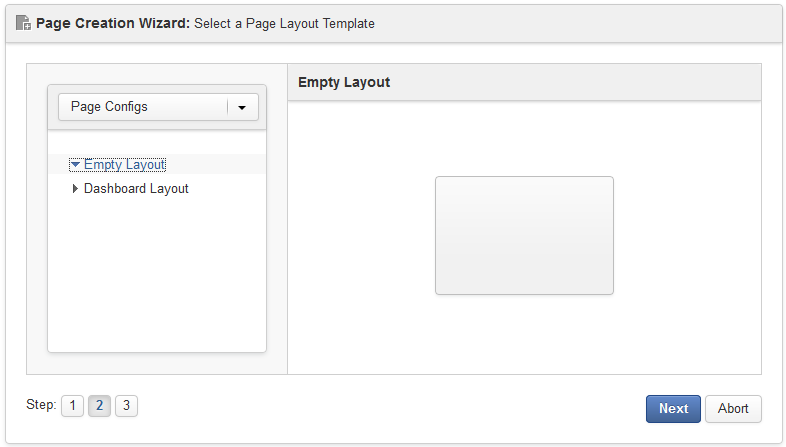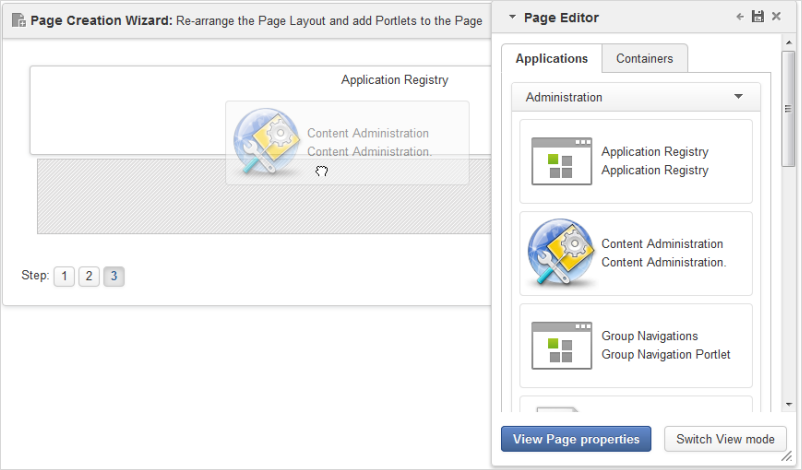Before diving into how to add a new page, you need to clarify the relationship between navigation node and page. Node and page are two entities that are totally different and a node can be referenced to a page. A page can only be accessed by users via a node.
The Page Creation Wizard is available to the portal's administrators and facilitates them to create and publish portal pages quickly and easily. In this way, you are creating a navigation node and its page together.
The whole process to create a new page can be divided into 3 specific steps:
Step 1: Selecting a navigation node and creating the page
In the first step, you have to set Node Name and Display Name of your page. You are also able to decide the pages visibility and the publication period of the page.
Open the site to which you want to add a new page. You will be switched to your selected site only after a few seconds.
Click
 on the top navigation bar, then select → from the drop-down menu to open the Page Creation Wizard form.
on the top navigation bar, then select → from the drop-down menu to open the Page Creation Wizard form.

The wizard is divided into two sections.
The left panel contains existing pages/nodes displayed in the tree hierarchy. Here, you can navigate up and down the node/page structure.
The right panel displays Page Editor where you can make changes on the selected navigation node. You can input parameters for your new page in this panel.
In which:
Field Description Selected Page Node The path of the selected node to add a new sub-page. Node Name The node name of the added page. This field is required, unique and must start with a letter. Only alphabetical, numerical, dash and underscore characters are allowed for this field with the length between 3 and 30 characters. Extended label mode Ticks the checkbox to show the Language field for you to select another language for your created node's display name. It means that if this checkbox is deselected, the Language field will be deactivated. Language Selects your desired language for the node's display name from the drop-down menu. Display Name The display name of the node which contains the added page and its length must be between 3 and 120 characters. Visible Toggles the global visibility of this page.
If this option is checked, the page or the page node appears on the navigation bar, the page navigation and the sitemap. If "Visible" is checked, the visibility also depends on the Publication Date & Time option.
If not being unchecked, the page is hidden under any circumstances, even if the publication period is valid.
Publication date & time Allows the page to be published for a given period. If this option is checked, Start Publication Date and End Publication Date will be shown. Start Publication Date The start date and time to publish the page. End Publication Date The end date and time to publish the page. Note
If a node is not visible (the "Visible" option is unchecked or the current time is not within publication period), it does not appear in any navigation or site map, but is still accessible via its URL.
Click Next or number '2' of the wizard steps to go to Step 2.
Step 2: Selecting a page layout template

Select Empty Layout or click the down-arrow icon in the left panel to see more templates and select one.
Click Next or number '3' of the wizard steps to go to the last step.
Step 3: Arranging the page layout
In this step, you can arrange the page's layout by:
Adding your desired applications, containers or gadgets by dragging and dropping them from Page Editor to the main page body.

In which:
Tab Description Applications This tab lists all existing categories and their portlets that you easily can drag and drop into the container. Containers This tab contains all existing containers to build your page layout. You can add a container to your page area by dragging and dropping available containers from Page Editor to the main page body.
There are various layouts available, including Rows Layout, Columns Layout, Autofit Columns Layout, Tabs Layout and Mixed Layout.
For Tabs Layout, you can add more tabs to the layout, and reorder the position of the tabs.
For each layout, you can edit different layers, from the parent container to its child containers. The parent container holds its child containers and the child containers can hold applications. You can also drag a container to another one that helps you create various layouts to your desires.
Remember that you can also drag and drop the container to another one that helps you create your own various layouts to your desires.
For any container layout, you can edit the parent container or its child containers separately. Deleting the parent container means that its child containers are removed as well.
You cannot drag and drop a child container to change its location, but can drag it outside its parent container.
Rearranging elements in the page body by dragging and dropping them into your desired positions. Also, you can edit or remove any element by hovering your cursor over it and selecting
 , or
, or
 respectively.
respectively.
Viewing page properties by clicking View Page Properties at the bottom of the Page Editor window.
Previewing your changes by clicking Switch View Mode.
Note
Click
![]() in the
Page Editor
window to save all changes, or
in the
Page Editor
window to save all changes, or
![]() to close without saving your changes.
to close without saving your changes.
In this way, the page only will be created. Thus, to make this page accessible, you need to create a node that links to this page (in the Page Selector tab). See Adding a new node for more details.
Select at the bottom. The form with the Page Settings tab opened will display as below.

In which:
Field Description Page Id The page's identification string which will be automatically generated when the page is created. Owner Type If Owner Type is "portal", the page is created for a portal. Therefore, only users who have the Edit permission on the portal can create this page type.
If Owner Type is "group", the page is created for a group. Therefore, only users who are the manager of that group can create this page type.
Owner Id The identification name of the page's owner which will be automatically created after you have selected Owner Type. When the owner type is set to "group", a list of groups will allow you to select one user as the 'owner'.
The name of the current portal is automatically selected for Owner Id, ensuring the Edit permission is assigned to users who can edit the current portal.
Page Name The page name which is required, unique and starts with a letter. Only alphabetical, numerical, dash and underscore characters are allowed with its length from 3 to 30 characters. Page Title The page title which is optional with its length from 3 to 30 characters. Show Max Window The option enables the page to be shown at the maximum size or not. Define the page layout in the Page Layout tab.
Define permissions in the Permission Settings tab. This tab consists of two sub-tabs named Access Permission Settings and Edit Permission Setting.
The Access Permission Settings tab shows all users who can access the page:
If the value of the Owner Type field is "Portal", the name of the current portal is automatically selected for the Owner Id field, so that the Access permission is assigned to all users who can access the current portal.
If the value of the Owner Type field is "Group", the Access permission is assigned to all users who are the members of the group that is selected in the Owner Id field of the Page Settings tab.
To reassign the Access permission for the page, see details in the Access permission section.
The Edit Permission Settings shows all users who have the Edit permission on the page.
If the value of the Owner Type field is "Portal", the Edit permission is assigned to users who can edit the current portal.
If the value of the Owner Type field is "Group", the Edit permission is assigned to all users who are the members of the group that is selected in the Owner Id field of the Page Settings tab.
To reassign the Edit permission for the page, see details in the Edit Permission section.
Click to accept creating a new page.